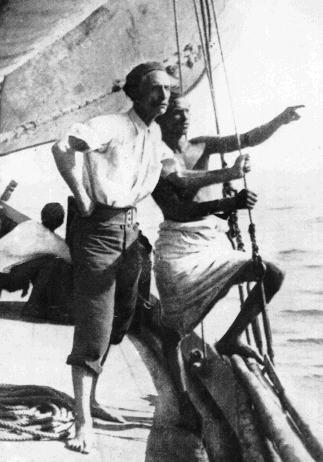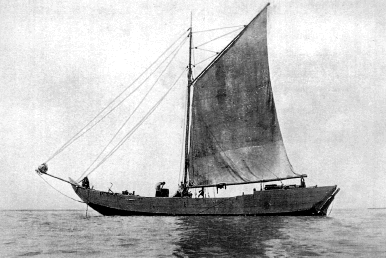Henry de Monfreid became a legend in his own lifetime for his exploits in the Red Sea and Ethiopia during the early decades of the last century. After returning to France from East Africa in 1947 he settled in Ingrandes, a picturesque village in the Vallée de l’Anglin, Indre-en-Berry, where he remained until his death in 1974 at the age of 95. He is buried in La Franqui, Aude, where he was born.
To celebrate de Monfreid’s remarkable life, a small museum was established at Ingrandes in 1990. De Monfreid is now also commemorated in Sana’a where Le Centre Français d’Archéologie et de Sciences Sociales recently changed its name to Le Centre Culturel Henry de Monfreid. The Red Sea coast of Yemen was, of course, the scene of several of Henry’s early escapades.
The de Monfreid house in Ingrandes (which passed first to Henry’s daughter Gisèle and then to his granddaughter, Amélie) is of fair size, surrounded by a wall, set on a steep slope overlooking the river l’Anglin, but hardly comparable to the more substantial 12th–14th century chateau nearby. The museum is in a house adjoining the de Monfreid property and more conveniently placed for public access. Here displayed in several rooms is a substantial collection of memorabilia highlighting different aspects of Henry’s long and prolific career as ‘Adventurer, Writer and Watercolourist’.
 |
| |
| Henry de Monfreid in the
Red Sea |
De Monfreid’s reputation as an arms smuggler aroused the obsessive suspicion of the British authorities in Aden during and following the First World War. And the museum proudly displays the expulsion order, issued in August 1917 and signed by the then British Political Resident, Major-General J.M. Stewart, banning him from Aden for the duration of the war.
In 1919 my father, Maurice Lush, en route to Addis Ababa to join the British Legation there, visited Djibouti which he described in his memoirs as ‘the home of the famous contrabandist de Monfreid, author of
Pearls, Arms and Hashish* and other books on the Red Sea’. He added: ‘There exists in some collection of archives at Oxford a memorandum by myself on the Arms Traffic in Abyssinia in 1920 [which] I think I must have written after meeting Henry de Monfreid... He lived on a hill above the sea near Djibouti in a villa where his wife... played Chopin divinely on a grand piano which was wheeled in the evening haze onto the patio!’
 |
| |
De
Monfreid’s house in Ingrandes.
Photograph: Julian Lush |
De Monfreid’s books about his extraordinary life, first published in the 1930s, won him a popular readership and international acclaim for their epic appeal and anthropological interest. Amongst his many admirers was the British explorer Wilfred Thesiger who, writing of his own travels in Ethiopia in 1935, recalled in his autobiography,
The Life of My Choice, that:
‘I had bought de Monfreid’s Les Secrets de la Mer Rouge and Aventures de Mer in Addis Ababa, and had just finished reading them. I had found his account of a wild and lawless life fascinating. He had come to Jibouti in 1910 as a clerk in a commercial firm, but soon found he had nothing in common with the petit bourgeois mentality of his fellow Frenchmen. The Danakil, however appealed to his romantic nature, and he learned their language and spent all his spare time consorting with them… he threw up his job and became a Muslim [adopting the name Abd-al-Hai] and virtually a Danakil. He bought a dhow, enlisted a crew, fished for pearls off the Farsan islands and ran guns into Abyssinia through Tajura, to the fury of the long-established French gun-runners who traded more or less officially. When his dhow was wrecked he built himself another, which he named
Altair… [When] we arrived in Jibouti…there among the native craft was de Monfreid’s
Altair; he was now in France and the boat was for sale. I later went on board and met some of his crew, whose names I already knew from his books, and I was half tempted to buy the boat and see if I could make a livelihood trading and pearling in the Red Sea. De Monfreid had bridged the gap between himself and his crew, identifying himself with them to the extent of becoming one of them. He had been rewarded by their acceptance, and I envied him his achievement…’
 |
| |
De
Monfreid’s boat Al-Tair which Wilfred Thesiger
visited
in Djibouti in 1935. |
According to the museum, de Monfreid wrote some 70 books, including numerous novels, although not all the titles are listed. His
Vers les Terres Hostiles d’Ethiopie, however, incurred the displeasure of Emperor Haile Selassie and led to his expulsion from Ethiopia in 1933 (he returned there after Mussolini’s conquest). Much less widely known is de Monfreid’s artistic talent inherited from his father Daniel, a painter and art dealer, who was Gauguin’s representative in Europe during the latter’s last years in Tahiti and the Marquesas, and also a friend of Toulouse-Lautrec. The museum exhibits several examples of Henry’s competent and colourful sketches, describing them as being ‘marked by a serenity oblivious of the ruggedness of his journeys, as if he wished only to retain fleeting impressions and primary emotions’, a characterisation which sounds better, perhaps, in the original French than in translation!
I hope that this note on the de Monfreid museum at Ingrandes (tel. 02 54 37 65 25) will encourage others to pay it a visit. Meanwhile, there is an exhibition commemorating his work in the field of photography –
En mer Rouge, Henry de Monfreid photographe – at the Palais de Chaillot, Paris, which runs until 2 October and sounds interesting.
* Pearls, Arms and Hashish: Pages from the Life of a Red Sea Navigator, Henri de Monfried (Gollancz, 1930) contains the oral account of his life which de Monfreid gave an American writer, Ida Treat, in c.1929. The book, to which Treat contributed a Foreword and Conclusion, was published under her name.
Vol
14. 2006
